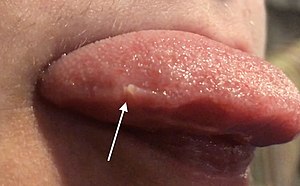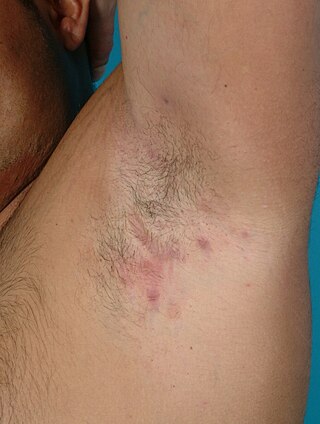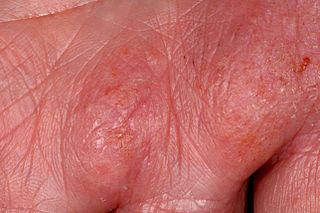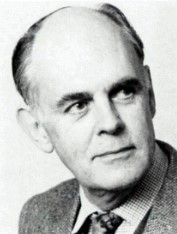| Transient lingual papillitis | |
|---|---|
| Other names | Fungiform papillary glossitis, [1] Eruptive lingual papillitis, [2] Lie bumps), [2] |
 | |
Transient lingual papillitis are painful, hypertrophic, red and white lingual papillae on the tongue. [2]
| Transient lingual papillitis | |
|---|---|
| Other names | Fungiform papillary glossitis, [1] Eruptive lingual papillitis, [2] Lie bumps), [2] |
 | |
Transient lingual papillitis are painful, hypertrophic, red and white lingual papillae on the tongue. [2]
Transient lingual papillitis can affect males and females as early as 3 years of age. In many cases, the cause is unknown. Some dental professionals believe the inflammation is due to chronic irritation from teeth, fillings, or dental appliances. Stress, poor nutrition, smoking, and alcohol use may also be initiating factors. [3]

Hidradenitis suppurativa (HS), sometimes known as acne inversa or Verneuil's disease, is a long-term dermatological condition characterized by the occurrence of inflamed and swollen lumps. These are typically painful and break open, releasing fluid or pus. The areas most commonly affected are the underarms, under the breasts, and the groin. Scar tissue remains after healing. HS may significantly limit many everyday activities, for instance, walking, hugging, moving, and sitting down. Sitting disability may occur in patients with lesions in sacral, gluteal, perineal, femoral, groin or genital regions; and prolonged periods of sitting down itself can also worsen the condition of the skin of these patients.

Darier's disease (DAR) is an inherited skin disorder that presents with multiple greasy, crusting, thick brown bumps that merge into patches. It is an autosomal dominant disorder discovered by French dermatologist Ferdinand-Jean Darier.

Gunther disease is a congenital form of erythropoietic porphyria. The word porphyria originated from the Greek word porphura. Porphura actually means "purple pigment", which, in suggestion, the color that the body fluid changes when a person has Gunther's disease. It is a rare, autosomal recessive metabolic disorder affecting heme, caused by deficiency of the enzyme uroporphyrinogen cosynthetase. It is extremely rare, with a prevalence estimated at 1 in 1,000,000 or less. There have been times that prior to birth of a fetus, Gunther's disease has been shown to lead to anemia. In milder cases patients have not presented any symptoms until they have reached adulthood. In Gunther's disease, porphyrins are accumulated in the teeth and bones and an increased amount are seen in the plasma, bone marrow, feces, red blood cells, and urine.

Ultraviolet light therapy or ultraviolet phototherapy is a treatment for psoriasis, atopic skin disorder, vitiligo and other skin diseases.

Lichen sclerosus (LS) is a chronic, inflammatory skin disease of unknown cause which can affect any body part of any person but has a strong preference for the genitals and is also known as balanitis xerotica obliterans (BXO) when it affects the penis. Lichen sclerosus is not contagious. There is a well-documented increase of skin cancer risk in LS, potentially improvable with treatment. LS in adult age women is normally incurable, but improvable with treatment, and often gets progressively worse if not treated properly. Most males with mild or intermediate disease restricted to foreskin or glans can be cured by either medical or surgical treatment.

Prurigo nodularis (PN), also known as nodular prurigo, is a skin disease characterised by pruritic (itchy) nodules which usually appear on the arms or legs. Patients often present with multiple excoriated lesions caused by scratching. PN is also known as Hyde prurigo nodularis, Picker's nodules, atypical nodular form of neurodermatitis circumscripta, lichen corneus obtusus.
Pityriasis alba is a skin condition, a type of dermatitis, commonly seen in children and young adults as dry, fine-scaled, pale patches on the face. It is self-limiting and usually only requires use of moisturizer creams.
Eosinophilic folliculitis is an itchy rash with an unknown cause that is most common among individuals with HIV, though it can occur in HIV-negative individuals where it is known by the eponym Ofuji disease. EF consists of itchy red bumps (papules) centered on hair follicles and typically found on the upper body, sparing the abdomen and legs. The name eosinophilic folliculitis refers to the predominant immune cells associated with the disease (eosinophils) and the involvement of the hair follicles.

Hay–Wells syndrome is one of at least 150 known types of ectodermal dysplasia. These disorders affect tissues that arise from the ectodermal germ layer, such as skin, hair, and nails.
Aquagenic urticaria, also known as water allergy and water urticaria, is a rare form of physical urticaria in which hives develop on the skin after contact with water, regardless of its temperature. The condition typically results from contact with water of any type, temperature or additive.
Whitfield's ointment is an acidic ointment used for the topical treatment of dermatophytosis, such as athlete's foot. It can have a slight burning effect that goes away after a few minutes. It is named after Arthur Whitfield (1868–1947), a British dermatologist.

The term pustular psoriasis is used for a heterogeneous group of diseases that share pustular skin characteristics.

Hand eczema presents on the palms and soles, and may sometimes be difficult or impossible to differentiate from atopic dermatitis, allergic contact dermatitis, and psoriasis, which also commonly involve the hands. Even a biopsy of all these conditions may not result in a definitive diagnosis, as all three conditions may demonstrate spongiosis and crusting on the hands.
Hydroxyethyl starch-induced pruritus is an intense itching, lasting for as long as one year, occurring following hydroxyethyl starch intravenous infusion for vascular insufficiency.There is no treatment for the itch.
Brachioradial pruritus is an intense itching sensation of the arm usually between the wrist and elbow of either or both arms. The itch can be so intense that affected individuals will scratch their own skin to a bleeding condition.
The British Association of Dermatologists is a charity established in 1920 whose charitable objects are the practice, teaching, training, and research of dermatology. It produces the British Journal of Dermatology, a monthly peer-reviewed medical journal and organises annual conferences.
George Hector Percival FRSE FRCPE (1902–1983) was a British dermatologist, academic author and president of the British Association of Dermatologists.

Cicely Pearl Blair FRCP was a British dermatologist. She discovered that people who had albinism did not get blackheads, as they did not produce melanin, the pigment that makes the comedones black. She also wrote about rashes caused by brown-tailed moth caterpillars. After her retirement, she turned her hand to art and especially silver smithing, fashioning a "chain of office" for the president of the British Association of Dermatologists.

Arthur James Rook FRCP was a leading British dermatologist and the principal author of Rook's Textbook of Dermatology (1968), known as "Rook's", which reached its ninth edition in 2016.

Ian Wesley Whimster MRCPath was a reader of dermatology histopathology at St Thomas' Hospital, London. He gained international recognition for his study of comparative anatomy and experiments with reptiles, particularly observing their colour patterns in relation to their nerve supply. He was part of the medical student team that went into Bergen-Belsen concentration camp in 1945, after it was liberated by British troops. On return, he made numerous contributions to dermatology, including the definition of keratoacanthoma, the distinction between pemphigus and pemphigoid and descriptions of melanocytes and malignant melanoma. He died in a road traffic accident at the age of 55.